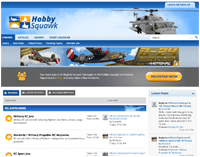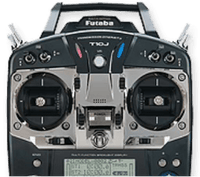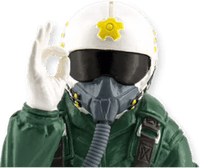Preflight Checks
von Motion RCWhether you are a full scale aircraft pilot or an RC pilot, it is absolutely essential to incorporate a thorough pre-flight inspection before piloting your aircraft each and every time to ensure the best chance of success and to establish a pattern of good safety practices.
Here are a common list of check offs to perform before any flight:
Control Surfaces - Make certain each and every control surface is tight. Ensure there aren't any tears in the foam hinge; if there are, reinforce them with hinge tape. Ensure that the control rods are the correct length and have adequate threaded contact between the rod and the clevis. Sometimes the control rods for the flaps and ailerons are different lengths and were switched during assembly. Check for loose screws, clevises, nuts, control horns, push rod and servo connections. You want to make sure you won't have any unwanted surprises during flight. The loss of a control surface in flight is almost always catastrophic.
Control Direction - Ensure that each control surfaces moves appropriately when you move the corresponding control stick on your radio transmitter. For example, when standing behind your airplane when it's on the ground, hold your aileron stick to the right. Your aircraft's aileron on the right/starboard side should move up, and the aileron on the left/port side should move down. One of the most common cause of maiden flight crashes is reversed control surfaces, so triple-check to ensure your control surfaces are not reversed. If they are reversed, change their setting in your radio. Refer to your radio's manual for exact instructions on how to do this, since the menu process differs per radio model.
Propeller - Make sure the propeller has not come loose, is not damaged or chipped in any way, and also check the spinner to make sure it is balanced. A good balanced prop and spinner will keep your plane from vibrating excessively during flight, which could increase wear and tear and eventually cause vital screws/nuts to become loose. While some vibration of the fuselage is normal, ensure that the fuselage does not shake erratically during a brief throttle-up test on the ground. This could be a sign of an unbalanced propeller or a loose firewall. Click here for our Prop Balancer selection.
EDF/Fan - If you are going to fly an EDF jet, it's always good practice to check your EDF unit to make sure all screws are tight or the unit is glued strongly in place. Make sure the intake(s) and fan(s) are clear of any debris such as dirt, rocks and other problematic elements. Also, attempt to clear any obvious rocks or debris in the path of your runway. It doesn't take much to have a rock or small piece of debris to suck into your intake on takeoff which almost always ends with a damaged fan blade or worse. Ensure any power wires or nearby servo wires are not in danger of being sucked into the fan.
Servos - We highly recommend using a servo tester to "exercise" each servo adequately before flight. Instead of merely moving a servo back and forth once or twice, a servo tester can be set to move a servo one complete cycle every second. If a servo is bad, there is a high probability that it will fail during the first 1-2 minutes of this "exercise". Thousands of servos are delivered in aircraft each week, and if you happen to receive a servo which fails this recommended pre-maiden flight servo test, please contact our Customer Service team to receive a free replacement servo under warranty. Servo Testers are a valuable component in any RC modeler's tool box. For more product information Click Here
Radio - Make sure your radio and receiver are functioning properly. Check that all control surfaces, gear, flaps and any other primary function you might have is working properly based on your inputs. If it's your first flight with the aircraft, also range check your radio to ensure a strong link even at a good distance away. If you find any issues, do not attempt to fly until everything is working properly. Many pilots neglect to range check their aircraft, which can be disastrous. Performing a range check before a maiden flight is a necessary prerequisite for consideration in any warranty claim.
Power Up - Have someone hold your aircraft (while safely out of the way of the propeller or EDF fan's thrust path) or if you are alone, place your feet in front of the horizontal stab and slowly apply throttle until full power just for a quick moment to make sure all is okay with your power system (motor, battery and ESC). Foam aircraft will vibrate a bit due to the material, this is normal. However, an excessive or uneven vibration could be a sign of a poorly balanced propeller, or a loose motor. If you detect any of these more serious issues, abort the flight and isolate and troubleshoot the issue. Never turn off the radio transmitter while the flight battery is still plugged into the aircraft. Always program any throttle failsafe features in your radio in advance, and with the propeller removed (if it is a propeller driven aircraft).
Center of Gravity - An aircraft with an incorrect CG will not fly properly. Double-check not only where the manual states the CG is, but also ensure you are measuring the CG in the correct way. For low wing aircraft, balance the model upside down. For high wing aircraft or mid wing aircraft, balance the model upright. For models with retracts, generally the CG is measured when the model is in its flight condition. When measuring CG for any aircraft, remember that when in doubt, it is always safer to be a little nose heavy than a little tail heavy. Most manufacturers will recommend a CG range, which pilots can experiment with to find their personal preference for how the aircraft handles. Nose heavy aircraft can be slower and more stable, while tail heavy aircraft can be more agile and sensitive to elevator or rudder input. It is always advised to maiden a new aircraft toward the front of a CG range, then making rearward adjustments on subsequent flights in minor increments of 1-2mm, only if needed.
Plan Your Flight - Look around for people, animals and obstructions. It's always a good idea to have a basic flight plan so you can be prepared for any problem that occurs in flight. Most AMA Flying Fields require a spotter. Having a friend to spot for you is very important and can often save your plane and/or others from damage in the event of a failed component, a dead battery, an incorrect Center of Gravity, etc. If you have to emergency land, make sure you know where any obstructions, people or animals are to avoid them in such an event. Spotter's are very valuable in identifying things like this, so your eyes and focus can remain on the aircraft itself. The more you survey your surroundings before the flight, the better your chances are of a positive recovery and outcome.
Get the latest from Motion RC sale and product announcements
You can unsubscribe at any time!

Hobby Squawk Community Forum
visit forum
RC Knowledge Blog
visit blog
Guidance & advice for beginners
Find out more- Wenn du eine Auswahl auswählst, wird eine vollständige Seite aktualisiert.
- Drücke die die Leertaste und dann die Pfeiltasten, um eine Auswahl zu treffen.
